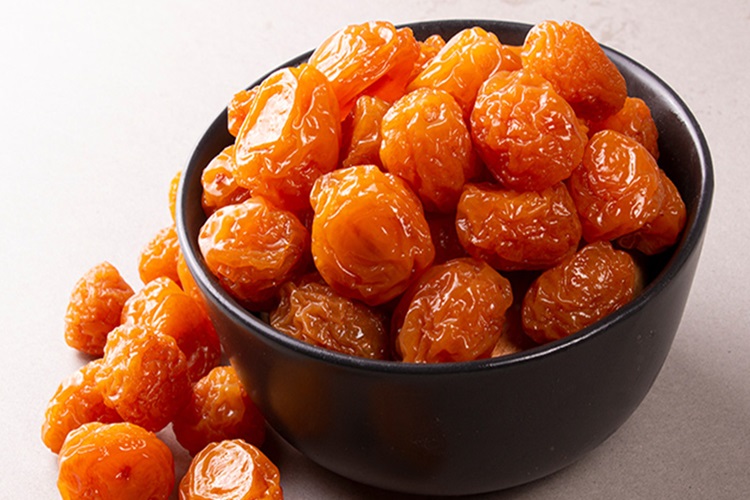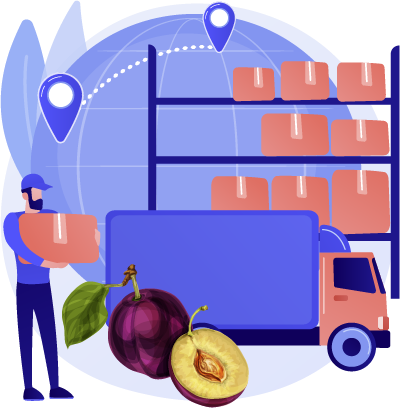Introducing plums
History and Origin
Plums are widely cultivated around the world and their varieties are adaptable to a wide range of soils and climates. This delicious fruit likely originated in the region around the Caucasus and the Caspian Sea, with a history of at least 2000 years. Ancient writings associate the early cultivation of plums with the area around Damascus. Another species of Old World plums probably originated in Europe or Asia. The Japanese plum was first domesticated in China thousands of years ago but was extensively developed in Japan and spread from there to other parts of the world. Iranian plums have a longer shelf life than many European varieties and are therefore the most common type of commercial plums.
Types of Plums
Iranian Dried Plums (Aloo Santrize)
Iranian Dried Plums (Aloo Santrize) are large, fleshy, red plums originating from European orchards. This fruit is reddish in color and very delicious, flavorful, and sour. It is used in many dishes, desserts, and sour sauces. Due to its fleshy nature, it is considered a good choice for drying.


Iranian Dried Plum (Aloo Bukhara)
Iranian Dried Plum (Aloo Bukhara), also known as dried plums, is one of the most widely used dried fruits in cooking and the food industry. The small golden plums with a different taste and color from other types of plums are known as Aloo Bukhara. This plum is also native to France and is used as a seasoning in many dishes in that country. In Iran, Aloo Bukhara is mostly cultivated in the mountainous regions of the northeast and northwest. This plum is rich in potassium and is beneficial for treating many diseases such as high blood pressure. Its dried form is usually used in various stews as it imparts a unique flavor and color to them.


Iranian Dried Plums (Aloo Baraghani)
Iranian Dried Plums (Aloo Baraghani) are known for their dark purple color. This beloved fruit originates in Western Asia but is now cultivated in many parts of Iran, especially in central and western regions. (Aloo Baraghani) belongs to the family of peaches, nectarines, and almonds and has a sweet and sour-sweet taste. It is very suitable for treating various diseases such as osteoporosis and is mostly used in dried form.


Iranian Dried Plums (Aloo Shablon)
Iranian Dried Plums (Aloo Shablon), with their sweet and mild flavor, seem to have been blessed by the sun with their sweet and delightful essence. This fruit is native to Europe and Asia, dating back thousands of years. This plum is among the very nutritious fruits that are a good source of vitamins, minerals, fiber, and many antioxidants. Aloo Shablon can reduce the risk of many chronic diseases such as osteoporosis, cancer, heart diseases, and diabetes. It also contains a small amount of vitamin B, phosphorus, and magnesium.


Understanding the Uses of Different Types of Plums
Cooking
-
Stews: One of the main ingredients in many Iranian stews, such as Ghormeh Sabzi, Aloo Esfenaj stew, and Fesenjan stew. The sour-sweet taste of plums adds depth and complexity to these stews.
-
Rice dishes: Can be added to various rice dishes, such as saffron rice, mixed rice, and steamed rice, giving them a unique taste and texture.
-
Soup: Can be added to soups, such as barley soup and lentil soup, to enhance their flavor and nutritional value.
-
Salad: Plums can be added to salads to give them a new taste and texture.


Food Industry
-
Jam and compote: Plums are one of the main ingredients in plum jam and compote.
-
Pastries: Can be added to various pastries, such as cakes, cookies, and biscuits.
-
Ready meals: Can be added to ready meals, such as instant soups and noodles.
-
Dried fruit: Can be consumed alone as a healthy and nutritious snack.
Health Benefits of Plums
In addition to their delicious taste, plums also have numerous health benefits, including:
-
A good source of fiber that helps digestion.
-
Rich in antioxidants that protect the body against cellular damage.
-
A good source of iron that helps maintain healthy blood.
-
A good source of potassium that helps regulate blood pressure.

Plums are a nutritious food that can be used in a variety of dishes and drinks
Guide to Choosing the Best Type of Plum
- Each type of plum has a somewhat overlapping use with others, but each has its unique taste and texture.
- Iranian Dried Plum (Aloo Bukhara) and Iranian Dried Plums (Aloo Santrize) are mostly used in stews and rice dishes, while Iranian Dried Plums (Aloo Shablon) and Iranian Dried Plums (Aloo Baraghani) are more commonly used in making dried fruits, nuts, snacks, salads, desserts, and various mixes.
- Choosing the type of plum depends on your taste and preference and the type of food you cook.
- No matter which type of plum you use, this delicious and nutritious fruit can add an extraordinary flavor to your dishes and snacks. By trying different types of plums, you can discover a world of flavors and health benefits.
Export of Plums from Iran
The export of plums from Iran has a long history, and this product is considered one of the important non-oil export items of the country.

Export Destination Countries
- Asian countries: Russia, Turkey, Iraq, United Arab Emirates, Afghanistan, Pakistan, India, and China.
- European countries: Germany, Italy, Spain, Netherlands, and the United Kingdom.
Export Volume
The volume of Iran's plum exports has fluctuated in recent years. However, overall, the trend has been increasing. In 2023, approximately 100,000 tons of plums were exported from Iran to various countries.
Factors Affecting Exports
- Product Quality: The quality of Iranian plums is one of the most important factors influencing its export. Iranian plums are highly popular in global markets due to their unique taste, aroma, and properties.
- Product Price: The price of Iranian plums is competitive compared to other exporting countries.
- Government Support: The Iranian government supports the export of agricultural products, including plums. This support includes providing banking facilities, export subsidies, and tax exemptions.
- Marketing: Proper marketing is one of the crucial factors in the success of Iran's plum exports.
Benefits of Plum Production at Ragiran
- Use of Fresh and High-Quality Plums: The plums used in the production process are selected from local orchards with high quality.
- Adherence to Hygiene in All Production Stages: Hygiene is carefully observed at all stages of production, from harvesting to packaging.
- Use of Advanced Methods for Drying Plums: Modern methods and up-to-date equipment are used for drying plums.
- Production and Packaging According to International Standards: Adherence to international standards in the production and packaging of products.
- Providing Products with Custom Packaging as Required.
Proper Storage of Plums
- Storage in a Cool and Dry Place: Store plums in a cool, dry place, away from direct sunlight.
- Use of Airtight Containers: To maintain freshness and higher quality, use airtight containers for storing plums.
Transportation Methods
Various transportation methods for shipping plums include air, sea, and land transport, which are chosen based on customer needs and destinations.
Sample products can be provided before bulk orders
For the most accurate pricing information about plums, please contact the sales consultants at Ragiran.












